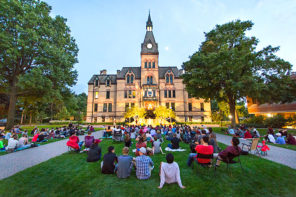Claude Lévi-Strauss, the anthropologist and philosopher, has died. He was 100 years old. He was the son of a portrait painter, the grandson of a rabbi, and the great-grandson of a violinist. He was born in Belgium, raised in France, and spent time in the Americas as a professor and an ethnographer. He studied at the University of Paris, held an academic post at the University of Sao Paulo in Brazil, worked at the New School for Social Research in New York City, was a Director at the École Pratique des Hautes Études, and served as the Chair of Social Anthropology at the Collège de France. He was married to three women, Dina Dreyfus in 1932, Rose Marie Ullmo in 1946, and Monique Roman in 1954. He is survived by his third wife and his two sons, Laurent and Matthieu.
We Are the Ones Who Define Religion
I never met the man Lévi-Strauss. I never shook his hand. I never saw him deliver a public lecture. But I did meet the myth. Lévi-Strauss first appeared in my undergraduate philosophy and religious studies classes as the blackboard placeholder for structuralism. The name and the idea were that which I learned, with the help of my Foucault- and Derrida-reading professors, to define myself against. We were poststructuralists. We no longer believed in the myth of the universal. We no longer imagined ourselves as a cosmically and consciously connected humanity. That epoch had passed. It was no more.
Everything I learned about Lévi-Strauss was a negation. He used myths from one culture to make sense of myths in another culture, moving across time and place. We contested those movements. He assumed that the signifier and the signified were linearly connected. We rejected that assumption. In contrast to his structuralism, we qualified our comparisons and tempered our generalities. We made it our task to be historical. We limited our analysis to the local. For every claim, we had a footnote. Don’t confuse us with structural anthropologists or systematic theologians. We do not make myth. We study the mythmakers. We are religious studies scholars.
This point was made clear to me in a graduate school class on “Teaching World Religions.” Ripping through textbook after textbook, we deconstructed the very categories of religious difference. There’s no such thing as Hinduism, Buddhism, Islam, Judaism, or Christianity. There’s just too much historical and geographical variation in practice. Extracting a set of beliefs, habits, or rituals out of a particular place and projecting them as universally representative of a religious tradition is, at best, methodologically irresponsible or, at worst, ethically inexcusable. As scholars of religion, we only can observe people in different places and different times practicing rituals and expressing beliefs that we call religion. And this is important. We are the ones who define religion. This is what makes us poststructuralist. We are aware of our own definitional constructions and we know that our comparisons are contingent on those constructions. We construct. We do not create. And unlike those structuralists of old, we profess that our categories, indeed all categories, have a history. If we undertake a comparison, it is done with the full knowledge and disclosure of our social, historical, and cultural (if one still believes in such a thing as culture) location (not to mention the complexities of our gendered, raced, and classed identities).
“I am certainly not the father of structuralism.”
But, I quickly learned in the classroom, students don’t want to hear such crazy talk. No such thing as Buddhism! Please, just tell us what they believe. Most students want to read myths and they want to feel cosmically connected. When they say they want to know about Buddhism, they really just want to feel like they “know” Buddhism. Launching into a historical narrative of the tradition often yields complaints such as, “This is so much information.” Or showing how Buddhists have practiced in different ways or believed different things depending on when and where they lived often yields responses such as, “How am I supposed to know if I disagree with those people if I don’t know where they stand?” These kinds of students desire myth. They would much rather read Huston Smith and Joseph Campbell than endure Edward Said or Talal Asad. But I the poststructuralist pedagogue, in an effort to maintain my intellectual integrity, deny them those pleasures. If only we could go back to the days of that old-time structuralism. If only we could just read myth without being burdened by history and worried about our own social position.
My classroom manners, outside of conference presentations, are my primary public performance for my scholarly opposition to structuralism. I have imagined structuralism to look like those world religions textbooks. And I have associated structuralism with Lévi-Strauss, though I mark it with other figures like Durkheim, Eliade, and later comparative scholarship, like Wendy Doniger’s. But that intellectual narrative, like those works themselves, is a mythic creation. Post-structuralism questions the linear relationship between signifier and signified, yet links without qualification the man Lévi-Strauss to the myth of structuralism. But as Maurice Bloch noted in The Guardian, Lévi-Strauss was decentering subjects well before Foucault and Derrida took up the task. In Tristes Tropiques, for example, he decreed “the I is hateful.” And as cited in Edward Rothstein’s piece in the New York Times, Lévi-Strauss distanced himself from the intellectual movement, stating in a 1980s interview that “I practically don’t dare use the word ‘structuralist’ anymore, since it has been so badly deformed. I am certainly not the father of structuralism.”
No father figure to rebel against? This is disconcerting. As a religious studies scholar, I need that myth. I need to tell myself that I neither create nor destroy. I only construct and deconstruct. But perhaps the passing of the man Lévi-Strauss provides an appropriate moment to decenter the mythic Lévi-Strauss of structuralism, reexamine the Lévi-Strauss of the text, and return to the question of comparison. All comparisons are fraught with danger. But are all comparisons necessarily mythic, or at least allegorical? Do they require some kind of imagined connection between different people in different places and different times? And what facilitates those comparisons? If not the mind, is it some kind of materiality, of objects, language, rituals, or habits?
Lévi-Strauss, the alleged father of structuralism, leaves behind a catalog of works, including The Elementary Structures of Kinship, Tristes Tropiques, The Savage Mind, and the four volume Mythologiques.




